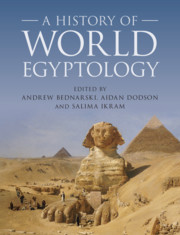Book contents
- A History of World Egyptology
- A History of World Egyptology
- Copyright page
- Dedication
- Contents
- Figures
- Notes on Contributors
- Preface
- A Note on Academic Titles
- Abbreviations and Conventions Used in Text
- Maps
- Introduction
- Chapter 1 The Prehistory of Egyptology
- Chapter 2 Egypt
- Chapter 3 France
- Chapter 4 The British Isles
- Chapter 5 The Netherlands
- Chapter 6 Belgium
- Chapter 7 The Nordic Countries
- Chapter 8 Prussia and Germany
- Chapter 9 The Empire of Austria-Hungary and the Republic of Austria
- Chapter 10 Switzerland
- Chapter 11 Hungary
- Chapter 12 Czechoslovakia
- Chapter 13 Poland
- Chapter 14 Russia
- Chapter 15 Italy
- Chapter 16 Spain
- Chapter 17 United States of America
- Chapter 18 Canada
- Chapter 19 Japan
- Chapter 20 Australasia
- Chapter 21 Ancient Egypt in the Cinema
- Chapter 22 Past and Future
- Bibliography
- Index
Chapter 17 - United States of America
Published online by Cambridge University Press: 01 June 2021
- A History of World Egyptology
- A History of World Egyptology
- Copyright page
- Dedication
- Contents
- Figures
- Notes on Contributors
- Preface
- A Note on Academic Titles
- Abbreviations and Conventions Used in Text
- Maps
- Introduction
- Chapter 1 The Prehistory of Egyptology
- Chapter 2 Egypt
- Chapter 3 France
- Chapter 4 The British Isles
- Chapter 5 The Netherlands
- Chapter 6 Belgium
- Chapter 7 The Nordic Countries
- Chapter 8 Prussia and Germany
- Chapter 9 The Empire of Austria-Hungary and the Republic of Austria
- Chapter 10 Switzerland
- Chapter 11 Hungary
- Chapter 12 Czechoslovakia
- Chapter 13 Poland
- Chapter 14 Russia
- Chapter 15 Italy
- Chapter 16 Spain
- Chapter 17 United States of America
- Chapter 18 Canada
- Chapter 19 Japan
- Chapter 20 Australasia
- Chapter 21 Ancient Egypt in the Cinema
- Chapter 22 Past and Future
- Bibliography
- Index
Summary
Interest in ancient Egypt in the United States dates back to the founders of the new republic. The third president, Thomas Jefferson (1743–1846, in office 1801–09), created an Egyptian corner in his home at Monticello, which included a map of Africa, a sculpture of Ariadne, which he had mistaken for Cleopatra (VII), and a model of the Great Pyramid of Khufu, which had been a gift in 1802 from the French writer and Middle Eastern explorer the Comte de Volney (see p. 14, above), whose memoir was partly translated into English by Jefferson as Ruins of Empires. De Volney had credited the ancient Egyptians with being an African civilisation and their achievements clearly argued against the institution of slavery. The pyramid even made its way on to the great seal of the United States (see Fig. 17.1) and later the dollar bill. An unfinished pyramid depicted on the reverse of the seal had thirteen courses to symbolise the original colonies and was intended to signify strength and endurance. The ‘Eye of Providence’ atop the pyramid on the great seal was later adopted as a symbol by the Fraternal Order of the Masons. President George Washington (1732–99, in office 1789–97), many of his generals and at least eight signers of the Declaration of Independence were Freemasons, and the philosopher Thomas Paine (1737–1809) traced the beginnings of the order to ancient Egypt.
- Type
- Chapter
- Information
- A History of World Egyptology , pp. 406 - 430Publisher: Cambridge University PressPrint publication year: 2021
- 39
- Cited by



